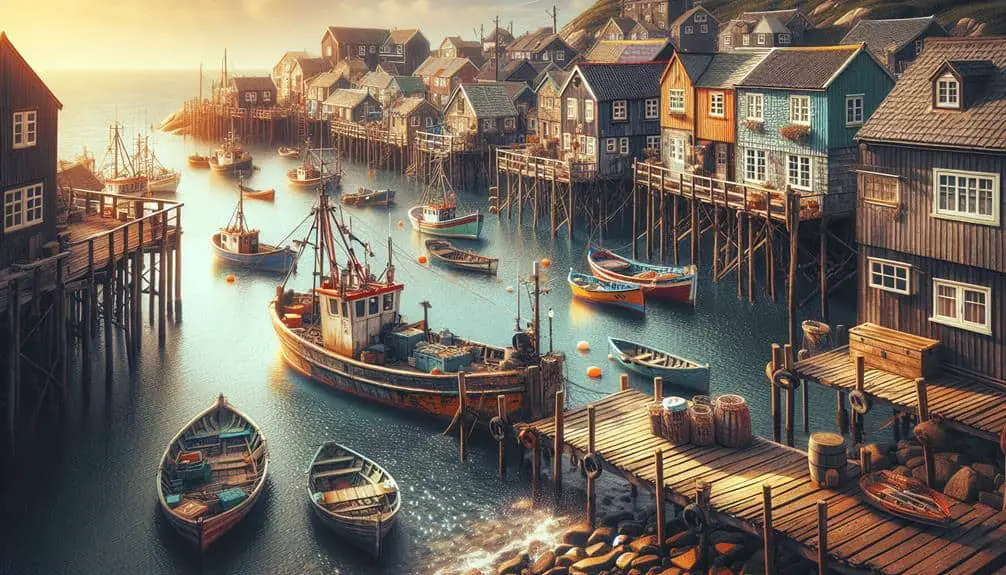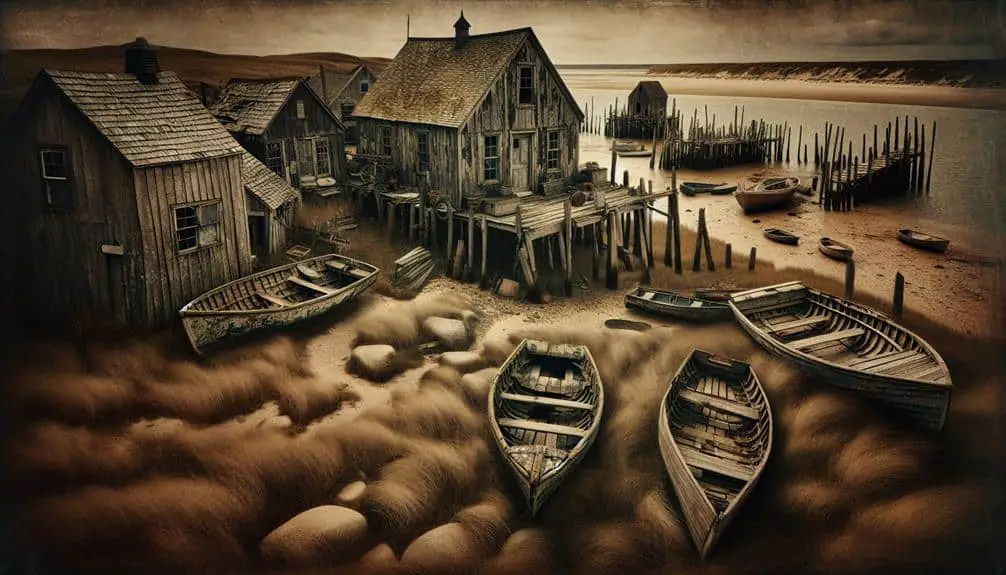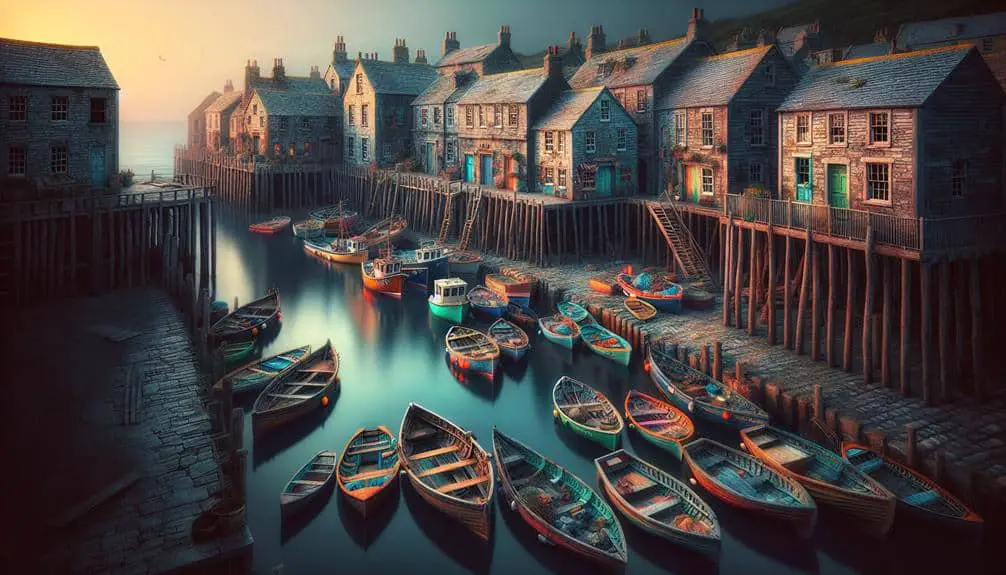Coastal fishing village remains intrigue you because of their rich history, unique architecture, preservation challenges, cultural heritage, and economic significance. These villages offer a glimpse into the past and showcase a blend of tradition and innovation. The resilience of these communities in the face of adversity sparks curiosity. Their architecture reflects a harmonious coexistence with the sea, while preservation efforts highlight the delicate balance between progress and conservation. Cultural traditions passed down through generations add depth and character. The economic impact and tourist appeal round out the allure of these coastal gems.
Key Points
- Mystery and nostalgia associated with ancient ways of life
- Architectural charm and unique design elements
- Cultural richness and preservation of traditions
- Resilience in the face of challenges and disasters
- Economic potential and tourism appeal
Historical Significance of Coastal Fishing Villages
The historical significance of coastal fishing villages lies in their pivotal role as economic hubs that sustained communities through the centuries. Archaeological discoveries in these villages have unearthed valuable insights into the past ways of life, trade networks, and cultural exchanges that shaped these coastal communities. The resilience of these villages in the face of natural disasters and economic hardships showcases the adaptability and strength of the human spirit.
Excavations in coastal fishing villages have revealed a wealth of information about the daily lives of inhabitants, including their fishing techniques, food preservation methods, and social structures. These archaeological discoveries provide a glimpse into the interconnectedness of these villages with other coastal settlements and inland regions, highlighting their importance in the broader historical context.
The community resilience displayed by these coastal fishing villages is evident in the way they adapted to changing environmental conditions, economic pressures, and social dynamics. Studying these aspects of coastal villages not only enriches our understanding of the past but also offers valuable lessons in sustainability and community building for the present and future.
Unique Architecture and Design Elements
Architectural features and design elements in coastal fishing villages exhibit a distinct blend of functionality and cultural aesthetics. The architectural charm of these villages lies in their practicality, with houses often built close to the waterfront for easy access to the sea. Design elements such as sloping roofs help protect against harsh coastal winds, while stilts raise structures above potential floodwaters. The use of locally sourced materials like wood and stone not only adds to the village’s charm but also reflects a sustainable approach to construction.
In addition to their functional aspects, the design elements of coastal fishing villages often showcase unique cultural influences. Intricate carvings on doorways, vibrant colors on facades, and asymmetrical layouts all contribute to the visual appeal of these villages. These design choices aren’t just arbitrary but are often steeped in tradition and history, telling stories of the community’s past and present. By blending practicality with cultural aesthetics, coastal fishing villages create a harmonious architectural landscape that continues to intrigue visitors and researchers alike.
Preservation Efforts and Challenges
Amidst the evolving landscape of coastal regions, efforts to preserve the architectural heritage of fishing villages face significant challenges. Challenges in preserving these historical sites often stem from limited funding, lack of awareness, and the constant threat of natural disasters. Community involvement plays a vital role in overcoming these obstacles. When local residents actively participate in preservation initiatives, it not only fosters a sense of pride and ownership but also secures the continuity of traditional practices and knowledge associated with these villages.
One of the primary challenges faced in preserving fishing village remains is balancing modern development with conservation efforts. As coastal areas become increasingly popular for tourism and urbanization, there’s a growing risk of losing these unique cultural sites to commercialization. Striking a harmonious balance between economic growth and heritage preservation requires collaborative efforts from the government, local communities, and conservation organizations.
Cultural Heritage and Traditions Preserved
Preservation efforts in coastal fishing villages face a myriad of challenges, yet the essence of cultural heritage and traditions remains resilient in the face of modernization pressures. The preservation of traditional practices within these communities plays a crucial role in upholding cultural heritage. Through the continuation of age-old fishing techniques, rituals, and craftsmanship, coastal fishing villages maintain a strong connection to their ancestral roots. These traditional practices not only sustain the livelihoods of the villagers but also serve as a proof of their rich cultural history.
Furthermore, community bonds are deeply intertwined with the preservation of cultural heritage in coastal fishing villages. The shared experiences of fishing expeditions, communal gatherings, and traditional festivals foster a sense of unity among the villagers. These collective activities not only strengthen social cohesion but also secure the transmission of cultural knowledge from one generation to the next. Essentially, the preservation of cultural heritage and traditions in coastal fishing villages isn’t merely a reflection of the past but a living proof to the resilience and endurance of these communities.
Tourist Appeal and Economic Impact
The influx of tourists in coastal fishing villages greatly impacts the local economy through various channels of expenditure and engagement. Tourists contribute to economic development by spending on accommodations, dining, and local products. Their presence stimulates the growth of small businesses such as souvenir shops, seafood restaurants, and guided tours. The tourist experience in these villages often involves activities like fishing excursions, cultural performances, and exploring historical sites, all of which generate income for the community.
Moreover, the economic impact extends beyond direct spending. The increased tourism creates job opportunities in hospitality, transportation, and tourism-related services, thereby boosting employment rates in these coastal areas. Additionally, the exposure to different cultures and traditions through tourism can lead to cultural exchanges and collaborations, further enriching the local community.
Frequently Asked Questions
What Are the Environmental Impacts of Coastal Fishing Villages on Marine Ecosystems?
When you contemplate the environmental impacts of coastal fishing villages on marine ecosystems, it is essential to understand the consequences of overfishing, which can lead to the depletion of fish populations, disrupting the balance of marine habitats and causing irreversible damage.
How Do Coastal Fishing Villages Contribute to Local Economies Beyond Just Tourism?
Coastal fishing villages contribute considerably to local economies beyond tourism. Through fishing industries, they drive economic development, create jobs, and sustain cultural traditions. Their impact goes beyond aesthetics, shaping livelihoods and regional identity.
What Role Do Women Play in Traditional Fishing Practices in Coastal Villages?
You might think men dominate the seas, but in coastal fishing villages, women are the unsung heroes. Their roles in traditional fishing practices are crucial, preserving cultural traditions and ensuring community sustenance.
How Have Modern Technologies and Practices Affected the Way Coastal Fishing Villages Operate?
Modern technologies like automation have had a significant impact on coastal fishing villages. While they can enhance efficiency, it’s essential to balance them with sustainable practices to safeguard the environment and preserve traditional ways of life.
Are There Any Superstitions or Myths Associated With Coastal Fishing Villages That Have Been Passed Down Through Generations?
Explore the rich tapestry of folklore and superstitions in coastal fishing villages. Generations have passed down tales of sea monsters, mermaids, and enchanted waters. These legends add a mysterious allure to these communities.



